#Commemorative coin issued
Explore tagged Tumblr posts
Text
Shopping with different OP characters!!
GN! reader, established relationship
warnings: stealing, doflamingo is an ASSHOLE
Includes: Crocodile, Nami, Doflamingo, Law, Kidd
My materialistic side really shows here💀
~-.-~~-.-~~-.-~~-.-~~-.-~~-.-~~-.-~~-.-~ ~-.-~~-.-~~-.-~
Crocodile
You had been begging Crocodile to take a break and go out with you all day. He really wanted to get work done, but just to shut you up, he finally agreed. You get all dressed up for a luxurious private dinner and afterwards the two of you take a walk through the city for some shopping, which is always fun with Crocodile’s bottomless wallet. As you’re walking, cozy underneath his big coat, a beautiful top catches your eye. You run up to the store window in awe of the striking piece that looks like it was made just for you.
“Wow, look at this one…” you say, trying to avoid flat out asking for it. You give him your best puppy dog eyes, fluttering your lashes as you blink innocently.
He knows what you want and responds, “you have a strange taste in fashion, but I’ll tell you what,” he chuckles and pulls out his wallet, “I’ll buy it for you if you let me choose something I want to see you in.”
You feign surprise, widening your eyes as you answer, “Really?” He laughs and pats your back, leading you inside the store.
Nami
Nami always ends up spending too much Beri when she goes shopping, and it’s even worse when she’s with you because she just can’t say no. So when the crew docks at a new island, the two of you agree not to spend any money on new clothes. Of course, a high end boutique catches your eye and you give Nami a mischievous glance, communicating you were gonna go in whether she wanted you to or not.
“I only want to try stuff on, I swear!” You exclaim over your shoulder.
“Fine, but don’t even try to convince me to pay for anything!” Your girlfriend tries to act annoyed, but her wide grin reveals her entertainment at your antics. Every time you show interest in something, Nami takes it into the dressing room next to you. You thought it was weird because the two of you have fairly different tastes. When you eventually leave the boutique, She pulls you close and opens her purse with a giggle to reveal all the clothes she had shoplifted for you. “See babe, I told you I wouldn’t pay for anything!”
Doflamingo
It’s a lazy Sunday morning for you and the King, lounging in bed with silk robes and the finest quality coffee. You’re flipping through a magazine while he reads some book about war strategy. “Doffy, what do you think about this one?” You ask. You don’t even have to consider money, Doflamingo can afford anything.
“Hmm…” he thinks for a minute, “I don’t think that’s your color.” You sigh. He always has to control everything. “What about this?” He points out something much more pink and extravagant.
“Why does everything always have to go your way?” You whine, fed up with his ego.
“You need to look good next to me,” he states firmly, putting an arm around your shoulder. “I have a reputation to uphold. Are you seriously not willing to sacrifice your fashion taste in exchange for everything else I give you?” The last thing you want is a fight, so you just rest your head on his chest as he calls in an attendant to order his picks for you.
Law
You had managed to drag Law to the mall with you, promising to go to the pawn shop with him afterwards to look for rare commemorative coins for his collection. When you see the cutest, chubbiest seal plushie ever, you know you have to have it. The only issue is that you have no money. Holding it behind your back, you turn to your boyfriend. “Law,” You begin your pitch, trying to look as cute and convincing as possible. “You really, really love me, right?” You tease.
“Of course I love you,” he answers, “but what are you scheming?”
You reveal the plushie to him and squeeze its cheeks. “I need this.”
He tries to hide his amused smile from you - you look so cute when you’re happy and he suddenly has the best worst idea ever.
“No, you don’t need it. You want it.” He takes the plushie from you. “Maybe another time, sorry babe.”
After a long day with your boyfriend, you had forgotten all about the seal plushie. The two of you arrive home and when he shuts the door he turns to you with a wide grin.
“What’s that look for?” You question playfully. He reaches into the shopping bag you made him carry and pulls out the chubby seal. You grab it from his hand and give him a lighthearted slap to the arm. “Law! You liar!”
Kidd
“Kidd, look at this!” You call to him while adjusting a choker around your neck. “Should I buy it?” You immediately regret showing him when a mischievous gleam lights up his eyes.
“Buy it?” Kidd taunts, reaching over to fasten the choker for you before grabbing several more. You’re frozen in place as he decks you out in accessories.
“What are you doing?” You question, “We can’t afford this!”
“You look cool!” He ruffles your hair and grins before whispering, “Now leave quick while I’m distracting the cashier.”
“Are you crazy?!” You whisper-yell. (Even though you already know the answer is yes.)
A shopkeeper interrupts your bickering, making you jump. “No playing dress-up in the store! Either pay or leave!” He scolds.
“Okay, bye then!” Kidd says to the shopkeeper before effortlessly throwing you over his shoulder and disappearing out the door.
~-.-~~-.-~~-.-~~-.-~~-.-~~-.-~~-.-~~-.-~~-.-~~-.-~~-.-~~
Thanks for reading!! Sorry for the doffy part
#one piece headcanons#one piece x reader#sir crocodile#crocodile x reader#sir crocodile x reader#cat burglar nami#nami x reader#donquixote doflamingo#doflamingo x reader#doflamingo x you#nami x you#crocodile x you#trafalgar law#trafalgardwaterlaw#law x reader#trafalgar d law x reader#eustass kid#eustasscaptainkid#eustass x reader#kidd x reader
350 notes
·
View notes
Text

BRITANNIA SC
Britannia - By Decree of the Senate
Trouble appears to have occurred in northern Britain at the start of the reign of Hadrian. This resulted in the arrival of the emperor, Roman victory and the construction of Hadrian's Wall. A commemorative issue of the 120s depicts Britannia for the first time on a coin. She is seated on a rock with a shield and standard. Britannia is still used nearly 2000 years later on modern British coins.
Hunterian Museum, Glasgow
#Britannia#roman coin#coins#roman coinage#archaeology#ancient cultures#ancient living#ancient symbols#roman empire#Roman wealth#coinage#metalwork#metalworking#roman army#roman soldiers#Glasgow#hunterian museum
54 notes
·
View notes
Text

A Tale of Two Coins - 2000 years apart!
On the right is a Judea Capta coin from 71 AD, 1952 years ago. The coin says “Judea conquered" in latin. These were commemorative coins originally issued by the Roman Emperor Vespasian to commemorate the capture of Judea and the destruction of the Jewish Second Temple by his son Titus in 70 CE during the First Jewish Revolt. On one side of the palm tree is a weeping defeated Jewish woman. On the other a victorious Roman soldier.
On the left, we see the same palm tree representing the Jewish homeland, but instead of a Roman soldier, there is a Jewish woman holding a baby up to the heavens symbolizing the rebirth of the Jewish people like a phoenix out of the ashes. In place of the weeping woman is a Jewish farmer (her husband) planting new roots for the Jewish people in the Jewish homeland. Instead of “Judea Capta'' the words read - “Israel Liberated 1948″.
These two coins sum up the history of exile and return of the indigenous Jews to the Kingdom of Israel.
In the prophetic words of the Bible: “They who sow in tears shall reap in joy.” (Psalm 126)
#secular-jew#israel#jewish#judaism#israeli#jerusalem#diaspora#secular jew#secularjew#islam#coins#ancient coins#judean coinage#judea#samaria#romans#judea capta#vespasian#titus#emperor#roman empire#Israel liberated#1948#hamas#coinage#second temple#1st century#palestine#Palestinian#gaza
386 notes
·
View notes
Text
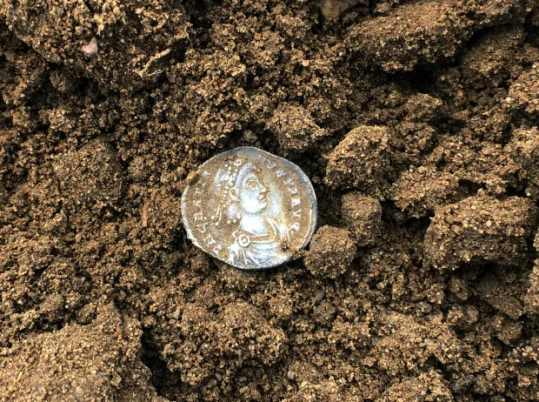
Roman Coin Hoard Found in England Sells at Auction
A hoard of Roman coins discovered by a metal detectorist scouring farmland has fetched more than £15,000 after going under the hammer.
More than 430 coins were found buried in the village of Colkirk, near Fakenham, Norfolk.
A collection of 73 pieces, including an extremely rare coin featuring a phoenix on a globe, was auctioned in London.
The anonymous finder had shown "perseverance", said coin specialist Nigel Mills, from Noonans auctioneers.
"Some of the people I've spoken to recently, who have found some amazing finds, are spending a lot of time detecting - hours and hours - and they don't give up," he said.

"They keep going and that's the secret in so many things - don't give up, keep looking."
The Colkirk hoard, believed to date back to the early 5th Century, was spread out across a third of an acre on arable farmland, although the majority of finds were discovered in a 1.5m (59in) radius.
It was a lucky find for the detectorist, who had no idea the soil held such treasures.
They were out searching a field in January 2020 when they spotted a silver coin, which they recognised as a siliqua - a small, thin Roman coin.
It sparked a haul of 40 coins that day, with a further 40 found on the following one.
Covid lockdowns meant searches became more sporadic, but each discovery was logged with a portable GPS unit to accurately pinpoint the hoard's distribution.
In all, 315 coins were found in 2020, 114 in 2021 and three in 2022.
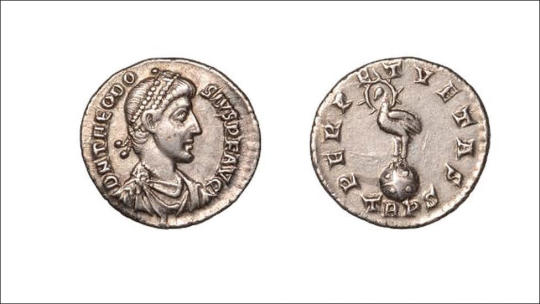
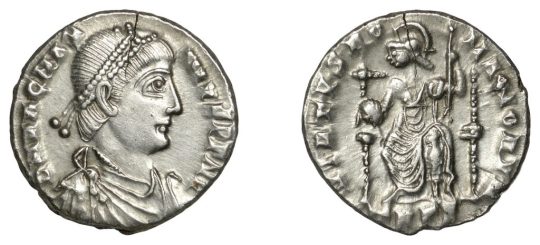
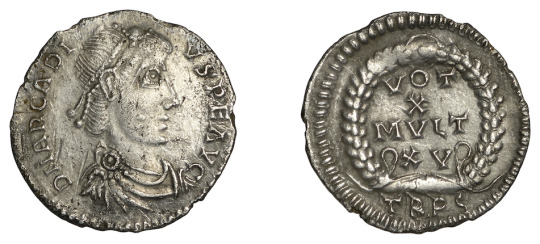
Some of the coins had been damaged, while others were fragmented due to farming processes.
A commemorative Third Miliarensis coin issued by Emperor Theodosius, decorated with a phoenix on one side, was only the fifth one of its type known to exist, with all the others in museums.
It reached £3,400 at the sale in Mayfair.
Mr Mills said: "The hoard had [been] spread out over a third of an acre through disturbance by ploughing and has been recorded under the Treasure Act.
"The hoard is likely to have been deposited at the beginning of the 5th Century AD, with the latest coin of Honorius dating no later than 402 AD.
"Other Roman treasure finds of gold and silver also from East Anglia, such as the Hoxne and Thetford hoards, reflect the wealth and importance of the area."
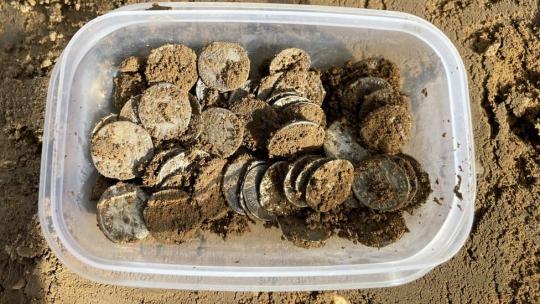
#Roman Coin Hoard Found in England Sells at Auction#village of Colkirk#metal detecting#coins#collectable coins#roman coins#ancient coins#ancient artifacts#archeology#archeolgst#history#history news#ancient history#ancient culture#ancient civilizations#roman history#roman empire#roman art
201 notes
·
View notes
Text
A3! Backstage Story Translation - Chikage Utsuki SR: Hide the REVERSE - Part 2

this is a request by taruchikas, who also provided a video of the story! tysm!
Chikage: —— Ah.
Izumi: Hm?
Chikage: Found it.
Kamekichi: Really!?
Sakuya: Thank goodness… You found it pretty easily.

Izumi: Oh, there’s a dog on this side.
Chikage: Yeah, this is a space dog named Laika…
Sakuya: …
Sakuya: Um… Is this really the coin you were using before?
Chikage: ——
Sakuya: I remember the coin you usually use having a scratch on it…
Chikage: … Nice memory.
Chikage: You’re right. This is just a spare.
Chikage: The other coin will be hard to find in the dark, and should the worst come to pass, I’ve got this one.
Chikage: There’s no point in dwelling on it now, so let’s call it a day.
Kamekichi: You sure…?
Sakuya: …
Chikage: You don’t need to worry about it. Really.
Chikage: Sakuya, Director, thank you both for helping me look for it. Kamekichi, reflect on your actions. Let’s break it up now.
Izumi: (Is he really okay with this…?)
-
Sakuya: I’ll look in the flower beds again. Kamekichi, you should go look on top of that tree.
Kamekichi: Roger! Leave it to me!
Chikage: …
Izumi: Good morning, Chikage-san.
Chikage: … Director-san, good morning.
Izumi: Sakuya-kun and Kamekichi have already started searching again.
Sakuya: Oh, Chikage-san, Director, good morning!
Chikage: There you are, even though I said you don’t need to worry about it.
Sakuya: You did, but you carry this coin with you all the time…
Sakuya: It may not be anything of importance, but I figured you might be attached to it.
Sakuya: And I’m attached to it too, because I’ve seen this coin almost every day ever since I met you.
Sakuya: Even if you’re not attached to it, it’s a special coin to me.
Chikage: Attached… That might be it.
Chikage: Then, can I ask you to help me look for it again?
Sakuya: Of course!
-
Izumi: It’s nowhere to be found…
Sakuya: Ah–
Sakuya: Or not…! Searching is easier now than it was last night, but it’s still hard to find it…
Kamekichi: — Ah! Something’s glittering over there!
Sakuya: Huh? Where?
Kamekichi: Over there! In the corner of the garden!
Sakuya: You mean there…?
Sakuya: …! There it is!

Izumi: Ah, you’re right, it has a scratch!
Chikage: Thanks. I didn’t think we’d find it.
Kamekichi: I’m so glad we found it! I had almost prepared myself to get grilled on a skewer!
Chikage: Now you’re just exaggerating.
Sakuya: Um… How did it get this scratch?
Chikage: … Do you want to know?
Sakuya: Yes!
Chikage: … When I was a kid, I wanted a commemorative medal from the museum so badly that I waited in line for hours to get one.
Chikage: But I was worried I’d drop it, so I asked the museum’s security guard at the entrance to hold on to it until the tour was over.
Chikage: Looking back, that was a pretty selfish request. But the security guard was happy to oblige.
Chikage: When I returned some time later, after the tour was over, there was a commotion at the entrance.
Chikage: The security guard I had spoken to was involved, and I jumped in to help without thinking.
Chikage: And that’s when I realized… he was confronting a robber.
Sakuya: A robber!?
Kamekichi: That’s not good!
Chikage: Before I could tell what was happening, the robber was in front of me. He started mercilessly coming at me with a knife.
Chikage: The security guard immediately got in front of me, and the robber stabbed him in the chest—!
Sakuya: Oh no…
Kamekichi: Dear god!
Chikage: … But he ended up alright, somehow.
Chikage: Why do you think?
Sakuya: Huh? Why did he…?
Kamekichi: Don’t tell me, he was actually immortal…!?
Chikage: He had the coin I entrusted to him in his uniform’s breast pocket.
Chikage: The knife’s tip hit the coin and got stuck there.
Chikage: The robber was then arrested by the police, who rushed to the scene, and the issue was resolved.
Chikage: Then, the security guard handed me the coin, smiled, and said…
Chikage: “I charged it with good luck for you.”
Sakuya: How cool…! Almost like it’s right out of a movie…!!
Kamekichi: I’m so moved!!
Izumi: (... I’m pretty sure only half of that story is real.)
-
Izumi: Ah, Chikage-san. Are you off to work?
Chikage: Yeah. I’ve been busy all morning.
Izumi: Fufu, we did have a pretty hectic morning.
Chikage: You can say that again.
Option 1: Still, I’m glad we could find it.
Izumi: Still, I’m glad we could find it.
Chikage: Yeah… Me too.
Chikage: I’ll take care not to misplace it again.
Izumi: You should. Or else Kamekichi will take it again.
Chikage: … I’ll grill him for real if he does it again.
Izumi: It doesn’t sound like a joke when you say it, Chikage-san, so please cut it out…
Option 2: By the way, was that story true?
Izumi: … By the way, was that story true?
Chikage: The story about the museum, you mean?
Izumi: Yes. I kind of doubt something so movie-like could happen…
Chikage: Sakuya and Kamekichi’s reactions were so interesting that I might have exaggerated a little.
Chikage: But well, it really is a meaningful coin… We can leave it at that.
Izumi: (Why does it feel like he’s trying to dodge the question…)
Izumi: (Well, I’m just glad he found the coin.)
Izumi: Oh. Can we have a coin battle?
Chikage: Now?
Izumi: Yes. Except this time, instead of guessing left and right, I’d like to try guessing whether it’s head or tails.
Chikage: … Alright.
[Chikage flips the coin]
Chikage: Here. Heads or tails?
Izumi: Hmm…
Izumi: (I tried to change the type of battle, but… I still have no idea…!)
Izumi: (... Uh, I don’t even know which is heads and which is tails for that coin…)
Izumi: (I suggested this, but I don’t even know that part…)
Chikage: —Sorry, It’s heads.
Izumi: (F-For now, I’ll—)

Izumi: … Tails!
Izumi: … I thought that was tails, though.
Izumi: Wouldn’t I be the winner then?
Izumi: (I-I’m sounding a little too desperate here…)
Chikage: … Pffft, hahaha.
Chikage: … Alright, you win.
part 1 | part 2
39 notes
·
View notes
Text
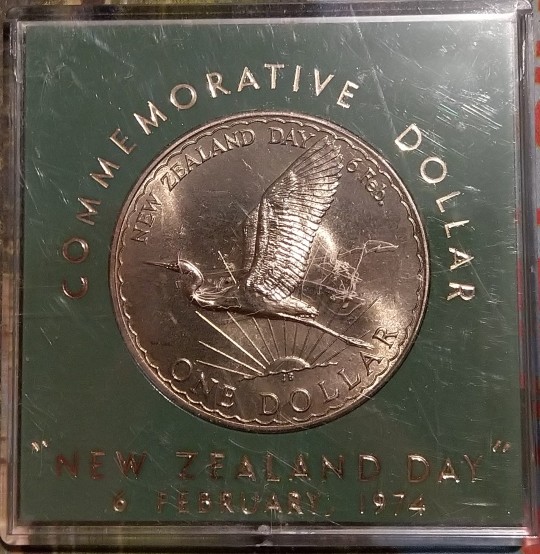
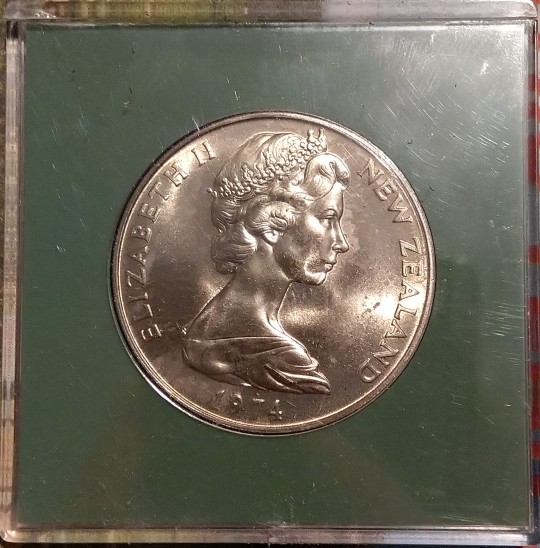
Since there's a bit of interest in the Treaty of Waitangi right now around here...
I've just acquired this coins commemorating New Zealand Day, 1974. Now, those of you who are kiwis might be thinking, wait, what? The reason you're thinking that is because 1974 was both the first and penultimate New Zealand Day.
In the mid-20th century, there was quite a lot of agitation from Maori for more recognition of the Treaty of Waitangi (signed in 1840 between the tribal chiefs and the British crown). Among more substantive demands, one of the requests was for the anniversary of the signing (February 6th) to be recognised with a national public holiday.
In 1960, despite its election promise, the Labour government didn't declare a real public holiday: Waitangi Day was made a 'national day of thanksgiving and commemoration', and a region could choose to move one of its other public holidays to February 6th if they chose. Obviously no one but Northland (home of Waitangi itself) did so.
Finally another Labour government took the step of making it an actual public holiday... called New Zealand Day! Apparently this was already celebrated by kiwi diplomats overseas so it's not totally without precedent. The PM and Minister of Maori Affairs at the time considered this a unifying move, making the day a celebration of nationhood. The first New Zealand Day was the one commemorated by this very coin in 1974, and was celebrated with a massive theatrical display at Waitangi and televised throughout the land. ("'Imaginative pageantry or tasteless vulgarity?' asked the New Zealand Herald.")
After just one more New Zealand Day (much quieter), the concept was brought to an end by the incoming National government, and specifically its infamous PM Robert Muldoon (look up the NZ 1984 sometime). He renamed the day back to Waitangi Day, possibly as a sop to Maori activists who really would have preferred he got on with this new-fangled "Waitangi tribunal" that he was meant to be setting up to deal with their genuine grievances.
So that's the start and end of New Zealand Day (all info from NZ History dot govt). Would it have been more unifying than the Waitangi Day we have now? Probably not - certainly that hasn't worked for Australia Day, and there are plenty of issues both historical and present to protest.
By the way, if there are any kiwis reading, I absolutely recommend going to Waitangi sometime (and ideally knock around Paihia and Kerikeri and Russell a bit too while you're at it). The museum, marae and historical buildings there give you so much perspective on what the Treaty was and why it was signed. Plus the views out into the Bay of Islands are really nice - and maybe if you arrive early enough in the morning, you'll see a great heron taking off against the rising sun, just like on this coin.
34 notes
·
View notes
Text
Fighting the Titans: Ptolemaic Victory over the Galatians

After the Galatians settled in Asia Minor, Northern Phrygia became a popular recruitment area for various competing Hellenistic monarchs. These Celts were known and respected for their military prowess. At the same time, the various kings of the ancient world occasionally waged war against them. These victories were then used in the royal propaganda to portray the monarch as a defender of civilization and liberty against these "barbarians." This perceived liberating role was often celebrated with the title "Soter" ("Savior"). The ambiguous love-hate relationship with the Galatians is clearly demonstrated in Ptolemaic Egypt, particularly during the reign of Ptolemy II.
Ptolemy II Philadelphos recruited some 4,000 Celtic warriors sometime during the 270s BCE. At the time, Ptolemy II was engaged in a conflict with his rebellious stepbrother, Magas, in Cyrenaica to the west. Magas, who became part of the Ptolemaic dynasty through his mother's marriage to Ptolemy I, had established a kingdom centered around the wealthy Greek colony of Cyrene in modern-day Libya. While Ptolemy headed west to address this threat, the Celtic mercenaries rebelled around 274 BCE.
According to Pausanias (1.7.2), the Celts sought to seize control of Egypt while Ptolemy II was preoccupied in the west. However, Ellis Berresford rightly notes that this claim is likely a gross exaggeration; a force of just 4,000 warriors would hardly have entertained such an ambitious plan. Instead, the Celts probably aimed to exploit the king’s absence by plundering Egypt’s numerous wealthy temples and towns before fleeing the country.
Ptolemy II, however, reacted swiftly and drove the rebels to an island near Sebennytos, where, according to Pausanias, they were starved into submission.
This victory was a minor event but quickly became a key element in Ptolemaic propaganda. The members of the Ptolemaic court, as well as the king himself, likely recognized the propaganda value of this triumph. As rival kings legitimized their rule through victories over Celtic tribes, Ptolemy seized the opportunity to join the ranks of these esteemed “liberator” kings.
Coins were issued featuring Galatian shields to commemorate this victory. Additionally, Ptolemy II was famously celebrated as a second Apollo in Kallimachos’ Hymn to Delos. In this work, the Hellenistic court poet recalls Ptolemy II's victory over the Celts in the following manner:
“Yes, and some day afterward a general conflict will come upon us, when the later-born Titans, raising up against the Greeks a barbarian sword and Celtic war, from the farthest west rushing like snow or equal in number to the heavenly bodies when they flock most thickly in the sky.” (transl. Dee Clayman)
Interestingly, Kallimachos describes the Celts as new Titans. The Titans were the older generation of gods who ruled the universe until they were overthrown by the Olympian gods under Zeus' command. If the Celts are the Titans, then the Ptolemaic king and his army are likened to the Olympian gods. This comparison between the Celts and villains from mythical history is not unique to Kallimachos’ poem. Similarly, in Attalid propaganda, parallels are drawn between their war against the Celts and the legendary Gigantomachy, the mythical victory of the Olympian gods over the Giants.
What is the purpose of this victory? It elevates the conflict with the Celts to an entirely new level. Just as the Titanomachy and Gigantomachy were remembered as triumphs of order, justice, and liberty, the subjugation of the Celts is meant to be celebrated as a victory over barbarism and chaos.
This reimagining of the wars against the Celts proved to be a powerful tool for legitimizing the Hellenistic monarchies in the eyes of the Greeks. The Greeks were naturally inclined to view kingship as an illegitimate and un-Greek form of government. Consequently, the kings employed these powerful mythological narratives to portray themselves as essential to the world order and worthy of rule, despite the autocratic nature of their governance. Moreover, if Zeus, a king, was accepted by the Greeks as the ruler of the cosmos, then why should the Hellenistic monarchs not be accepted as legitimate rulers?
In short, Ptolemy’s victory over the Celts, despite its limited scale, provided him with a triumph he could frame as a victory of order over chaos. This sent a powerful message throughout the Hellenic world: he was a god performing godlike deeds. Furthermore, as the Olympian gods were accepted by the Greeks as kings, why shouldn’t the Ptolemaic monarchy be afforded the same respect?
It is hard not to detect the hubris in this Ptolemaic mindset. They were mortals striving to be gods—or so it might seem. To the Ptolemies, there was no such contradiction: they were not merely mortals aspiring to divinity; they were gods. Through the dynastic cult and other forms of propaganda, they blurred the line between the divine realm and the Egyptian monarchy. Narratives emphasizing the kings’ similarities to the gods were widespread throughout the kingdom. For instance, the Ptolemies’ practice of sibling marriage mirrored the relationship between Zeus and Hera, who were also siblings. The story of the Celts aligns seamlessly with this broader propaganda effort, making its use entirely logical.
Olivier Goossens
#ancient history#archaeology#art history#hellenism#ancient greece#classical literature#ancient egypt#egyptology#celtic#celts#ancient celts
16 notes
·
View notes
Text
Moscow metro. Kropotkinskaya station.
The Kropotkinskaya station was planned in 1934 and opened on May 15, 1935. Until 1957 it was called the "Palace of Soviets". It received its current name from the Kropotkin Gate Square and Kropotkinskaya Street. It was part of the first section of the subway. The metro hall was conceived as an underground lobby of the Palace of Soviets, which was planned to be built on the site of the demolished Cathedral of Christ the Savior. The ten-sided columns of the station and the track walls are decorated with grayish-white Ural marble "koelga". The floor is lined with pink and gray granite in a checkerboard pattern. In 2005, a silver commemorative coin "Kropotkinskaya Metro Station" with a nominal value of 3 rubles was issued. The series "Monuments of Architecture of Russia".
#architecture#interesting#city#metro station#subway#subway station#train#travel#traveling#walking#city life#beautiful#beautiful place#places#urban#urban landscape#street#city vibes#city center
10 notes
·
View notes
Text
for legal reasons i do not want this to happen this is satire

HAPPY IDES OF MARCH EVERYBODY
i just yank a guy’s old otj and tweak it a little when i don’t have time to make a proper design. this was thomas nast’s columbia except not white
the thing shes wearing on her head is a ‘cap of freedom’ or a pileus. freed slaves wore them. thats a pileus on this coin brutus issued to commemorate the assassination

why does everything always come back to coins
this was really rushed and the more im looking at it the more im like oh shit her skin is NOT saturated enough she looks ASHEN……. though i have a history of using desaturated skin to represent illness (see: every picture ive drawn of andolont ever) so lets just call it that
i am learning how to render curly hair
that is the family guy death pose because i think combining classical imagery and meme culture is really funny
it’s not even the ides of march in my timezone yet but it is for somebody
14 notes
·
View notes
Text

Rita Hayworth (born Margarita Carmen Cansino; October 17, 1918 – May 14, 1987) was an American actress, dancer, and pin-up girl. She achieved fame in the 1940s as one of the top stars of the Golden Age of Hollywood, and appeared in 61 films in total over 37 years. The press coined the term "The Love Goddess" to describe Hayworth, after she had become the most glamorous screen idol of the 1940s. She was the top pin-up girl for GIs during World War II.
Hayworth is perhaps best known for her performance in the 1946 film noir Gilda, opposite Glenn Ford, in which she played the femme fatale in her first major dramatic role. She is also known for her performances in Only Angels Have Wings (1939), The Strawberry Blonde (1941), Blood and Sand (1941), The Lady from Shanghai (1947), Pal Joey (1957), and Separate Tables (1958). Fred Astaire, with whom she made two films, You'll Never Get Rich (1941) and You Were Never Lovelier (1942), once called her his favorite dance partner. She also starred in the Technicolor musical Cover Girl (1944), with Gene Kelly. She is listed as one of the top 25 female motion picture stars of all time in the American Film Institute's survey, AFI's 100 Years...100 Stars.
Hayworth was a top glamour girl in the 1940s, a pin-up girl for military servicemen and a beauty icon for women. At 5 ft 6 in (1.68 m) and 120 lb (54 kg), she was tall enough to be a concern for dancing partners such as Fred Astaire. She reportedly changed her hair color eight times in eight movies.
In 1949, Hayworth's lips were voted best in the world by the Artists League of America. She had a modeling contract with Max Factor to promote its Tru-Color lipsticks and Pan-Stik make-up.
For her contribution to the motion picture industry, Hayworth received a star on the Hollywood Walk of Fame at 1645 Vine Street in 1960.
In 1980, Hayworth was diagnosed with early-onset Alzheimer's disease, which contributed to her death in 1987 at age 68. The public disclosure and discussion of her illness drew attention to Alzheimer's, and helped to increase public and private funding for research into the disease.
The public disclosure and discussion of Hayworth's illness drew international attention to Alzheimer's disease, which was little known at the time, and it helped to greatly increase federal funding for Alzheimer's research.
The Rita Hayworth Gala, a benefit for the Alzheimer's Association, is held annually in Chicago and New York City. The program was founded in 1985 by Princess Yasmin Aga Khan, in honor of her mother. She is the hostess for the events and is a major sponsor of Alzheimer's disease charities and awareness programs. As of August 2017, a total of more than $72 million had been raised through events in Chicago, New York, and Palm Beach, Florida.
On October 17, 2016, a press release from the Springer Associates Public Relations Agency announced that Rita Hayworth's former manager and friend, Budd Burton Moss, initiated a campaign to solicit the United States Postal Service to issue a commemorative stamp featuring Hayworth. Springer Associates also announced that the Academy of Motion Picture Arts and Sciences would be lobbied in hopes of having an honorary Academy Award issued in memory of Hayworth. The press release added that Hayworth's daughter, Princess Yasmin Aga Khan, the Alzheimer's Association of Greater Los Angeles, and numerous prominent personalities of stage and screen were supporting the Moss campaign. The press release stated the target date for fulfillment of the stamp and Academy Award to be on October 17, 2018, the centennial of Hayworth's birth.
Daily inspiration. Discover more photos at Just for Books…?
8 notes
·
View notes
Text

Building Trajan's Column
Today, Trajan’s Column rises above the busy cityscape, dominated by the gargantuan Altare della Patria, built in the end of the 19th century. But when the monument was erected in the 2nd century CE, the 38-meter column was an integral part of the Forum of Trajan, a piece of art that celebrated Trajan’s splendid victory over the Dacians. The construction of the Forum began almost immediately after the end of the war. The endeavor was financed by the huge war booty seized from the vanquished Dacians. Most of the work was completed within five years. Trajan’s Column was put in place in 113 CE, with the special commemorative coin depicting the Column issued for the occasion.
8 notes
·
View notes
Text
As President Donald Trump was sworn into office as the 47th President of the United States on Monday, grifters and opportunists were already seeking to cash in on the new Trump era—including the president himself.
Just days before he took office, Trump launched a memecoin called $TRUMP to “celebrate our win and have fun," warning that it was “not intended to be … an investment opportunity.” Trump announced the launch on X and Truth Social, with many wondering if the president’s accounts had been hacked.
However, within hours, thousands had invested in the cryptocurrency. The sale was so successful that, at billions of dollars, it accounted for almost 90 percent of Trump’s overall wealth. However, like a lot of memecoins, the $TRUMP coin’s price fluctuated wildly and dipped significantly on Sunday, with the price drop continuing into Monday.
At the time he was sworn in as president on Monday, the $TRUMP memecoin was worth just shy of $50 billion, with Trump retaining 80 percent of the coins. The coin, which is built on the Solana blockchain, allows anyone anywhere in the world to funnel money directly to the US president.
First Lady Melania Trump also launched her own memecoin on Sunday, and while it hasn’t reached the level of Trump’s memecoin, the $MELANIA coin was worth almost $8 billion on Monday.
The president and first lady were far from the only ones seeking to cash in on the buzz around Trump’s second term, and the inauguration weekend in particular. Since his first term in office, Trump has been a magnet for all types of grifts and cash grabs, many of them endorsed by the president himself, and including everything from guitars and shoes to trading cards and coins.
Religion has also been on the table. Lee Greenwood, a country singer, said on Sunday that Trump could use a special edition of the “God Bless The USA” bible for his swearing in—the same bible the singer has been selling with Trump since last March.
The “Inauguration Day Edition Bible” has been on sale on Greenwood’s own website—alongside hot pink and camo versions of the bible—for $70 for the last week, but as Trump took office on Monday, the bible appeared to have already sold out.
A raft of other commemorative items are on sale, ranging from dozens of “Inauguration Day” t-shirts and hats being sold on platforms like Amazon and Etsy to a special “Inauguration Edition” roast from Victory Coffee. A Texas-based jeweller is even offering to gift the president an 8-carat diamond in the shape of his head in what appears to be a marketing bid.
And because Trump’s inauguration was moved indoors due to severe cold weather, tens of thousands of people who had been sent tickets to attend the event were unable to use them. People have attempted to cash in on those tickets, with dozens of listings on eBay offering the unused tickets for up to $200 each. The tickets were distributed free by members of the House of Representatives and feature a hologram and the signature of the representative whose office issued them. Many of the listings have already been sold, with some sellers offering multiple tickets.
A specific website offering commemorative inaugural tickets was also set up, with some tickets offered for as much as $900. It is unclear who is behind the page, but the site is ranked as the second result on a Google search for "commemorative inauguration tickets.”
Grifting and cash grabs in Trumpworld are nothing new. Ever since Trump came to office in 2016, he and his sycophantic supporters have embraced a wide variety of schemes. With Trump support, many figures have made entire careers grifting on topics like stolen elections or COVID denialism.
4 notes
·
View notes
Text
Why Hill Top Road is most certainly not the only portal: A theory I didn’t type out because I had thought to eventually write a fanfic about it, but here you go because it’s the last possible day for me to post a called shot with my tma theory without tmp lore being involved.
Section 1 - The Tree
When we’re first introduced to Hill Top road in MAG 08, the statement giver provides us with his gut-check instinct about the tree on the premises, which cast odd shadows and “creeped him the hell out”, culminating with him feeling the need to destroy it.
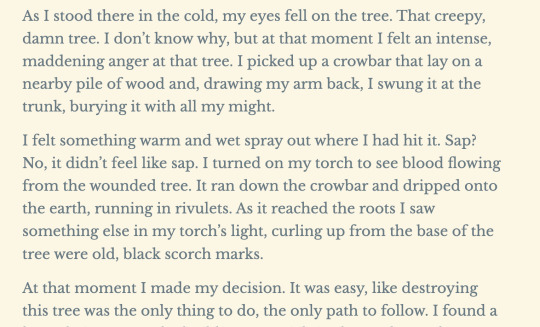
This tree, as we all understand by the end of MAG 196 - This Old House, is a symptom of the crack in reality seeping out from underground, but let me draw your attention to MAG 127 - Remains to be Seen, where Jonah hires Doctor Jonathan Fanshawe to visit Albrecht von Closen in the Schwartzwald, otherwise known as the Black Forest in Germany. When his carriage arrives, what does he see but some absolutely heinous tree that absolutely must be killed:
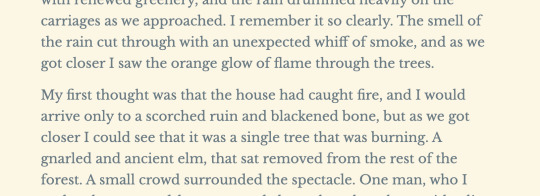
and then, later on:

A single tree so inexplicably foul, it inspires the urge to kill it dead. Section 2 - Underground In MAG 59 - Recluse, the orphan Ronald Sinclair wanders into the basement of Hill Top Road, and recounts his observations of the room:

Compare this with Anya Villette’s description in 114 of the unlisted HTR basement, involving unfinished masonry and damp earth

As a curious parallel, in Albrecht Von Closen’s experience descending down the strange, isolated mausoleum in the Schwartzwald, the tree-punctured, decaying stone stairway yields to a room with books touching walls so weather exposed, the statement giver is unable to tell if the books are truly touching walls at all, or are in fact bordered in with bare soil.
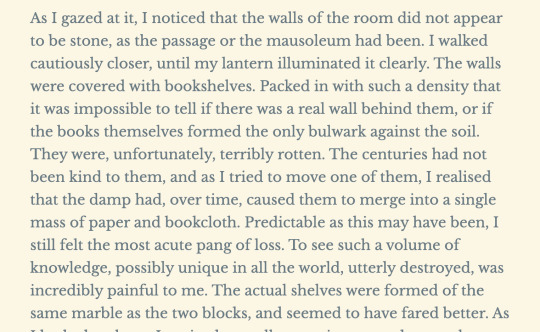
And what item did Albrecht find conspicuously on the floor of Johann von Württemberg’s mausoleum, the subtler mystery detail hidden by the much thematically larger mystery of the books? Section 3 -The coin anomaly Inside this strangely placed, isolated mausoleum in the Scwartzwald, Albrecht von Closen found a coin, dated the year the count Ulrich II of Württemberg passed away.

Interestingly, in both our universe and the in-fiction one, Eberhard I succeeded Ulrich II, and not any bastard named Johann. Our dear Archivist comments on this in the same breath as dismissing it as coincidence, which historically means it definitely isn’t.
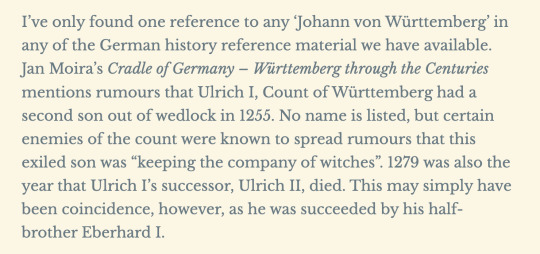
Preposterously familiar for anyone who’s spent any amount of time thinking about the obvious HTR-based disappearance/reappearance/time skipping of Anya Villette (MAG 114) and Anne Kasuma nee Willette (MAG 08). Kind of curious how this absolutely cursed book collection shows up in proximity of a cursed tree that people are urged to kill, in a weird mausoleum nobody has any record of, alongside a coin of a man who may not have existed and definitely wasn’t a lord or any sort of royalty and yet there’s currency commemorating him? This is not the end of the Scwartzwald anomalies, though. You see, this coin…went missing. Section 4 - Profound violence, and an eyeless man It’s unclear the circumstances of how Albrecht lost this coin, though given that he wrote his statement in 1816, I suspect it fell out from a pocket during Albrecht’s very next encounter which causes him to flee the Black Forest entirely. The encounter where the guy who keeps creeping around the outside of the mausoleum, issuing vaguely intimidating warnings, decides to accost Albrecht and reveals himself to have empty eye sockets, and the ability to “see” regardless.

The identity of the Eyeless man remains unknown definitively, as he runs off as if he was startled by some sort of predator, but in some Absolute Hunt Bullshit that seems to follow pretty much immediately, there was a murder that same year that investigators briefly thought was committed by Albrecht’s host and nephew, Wilhelm.

An eyeless man, a cursed tree, the profound violence of a hunt, the man who doesn’t belong with a history that couldn’t be true. And that’s not to mention the incredibly cursed vibes of both locations. To wit, in MAG 196 regarding the nature of these cracks in the universe:

Compare this to Albrecht’s description of the Schwartzwald:
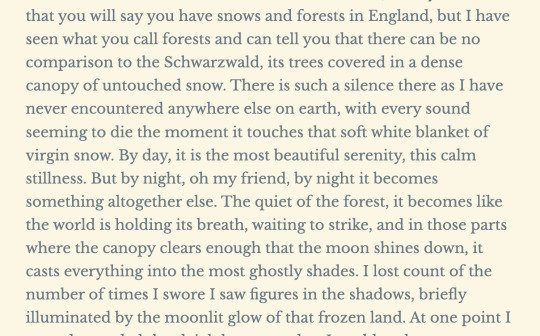
AND ALL THIS IS TO SAY, in my heart I know it’s true that there are more portals, because as a patreon subscriber I got to submit a question for the Q&A And do you know what they did? Do you know what happened to my question? They reworded it beyond recognition, to a thing that was NOT what I was on about at all. I asked about the potential for other Cracks in reality to exist currently, like the hints for Schwartzwald or The Eschatology Door in Paris, and do you know what they rewrote the question to be about (but still put my name on so I KNOW it was supposed to be mine) (also please dont go find it, it’s embarrassing how they butchered my ask and also it has my human name on it and I don’t know yall like that tbh, so just take my word for it)? The question they answered was if different places and countries had their own regionally specific fear domains, like Paris for example. Which like, obviously?? I forget how exactly they rephrased it, I was on a walk listening and my ears went hot and my eyes went wide and I KNEW I HAD SOMETHING WITH A MELTY HOT CORE OF TRUTH TO IT. Pure adrenaline, sign me up for the Fucked Up Red String Tower where People Judge Marble Domain I guess, but I feel it in my GUTS now. And you know, maybe the question was rewritten by a staff member before they ever saw it, any number of things could have happened along the pipeline. It seems bizarre to me that they’d even leave it in after choosing to rework it that hard, though. But I’ll tell you what, the question posed was about cracks in reality, not fear domains. And I feel CLOSE to something. In Annabelle’s own words,
Indeed, few have ever thought much of it at all. Perhaps there are many such places across the Earth. Perhaps it is unique. Certainly, no-one has known either way.
(PS don’t get me started on MAG 134 - Time of Revelation, DON’T GET ME STARTED ON IT)
Transcripts lovingly taken from https://snarp.github.io/magnus_archives_transcripts/ All the screenshots have alt texts with the contents in plain text. Mainly, the goal I set here was to get it out there before TMP, so I can feel very very clever if they ever address it. Also, this is my first effortpost using this editor and BOY YA'LL WEREN'T KIDDING.
36 notes
·
View notes
Text

Tooth fairy
Tooth fairy
The tooth fairy is a folkloric figure of early childhood in Western and Western-influenced cultures. The folklore states that when children lose one of their baby teeth, they should place it underneath their pillow or on their bedside table; the Tooth Fairy will visit while they sleep, replacing the lost tooth with a small payment.
Origins
During the Middle Ages, other superstitions arose surrounding children's teeth. Children in England were instructed to burn their baby teeth, on pain of spending eternity searching for the baby teeth in the afterlife. Fear of witches was another reason to bury or burn teeth. In medieval Europe, it was thought that a witch could assume total power over someone if they were to obtain one of their teeth.
Another modern incarnation of these traditions into an actual Tooth Fairy has been traced to a 1908 "Household Hints" item in the Chicago Daily Tribune:
Tooth Fairy. Many a refractory child will allow a loose tooth to be removed if he knows about the Tooth Fairy. If he takes his little tooth and puts it under the pillow when he goes to bed the Tooth Fairy will come in the night and take it away, and in its place will leave some little gift. It is a nice plan for mothers to visit the 5-cent counter and lay in a supply of articles to be used on such occasions.
Appearance
Unlike Father Christmas and, to a lesser extent, the Easter Bunny, there are few details of the Tooth Fairy's appearance that are consistent in various versions of the myth. A 1984 study conducted by Rosemary Wells revealed that most, 74 percent of those surveyed, believed the Tooth Fairy to be female, while 12 percent believed the Tooth Fairy to be neither male nor female, and 8 percent believed the Tooth Fairy could be either male or female. When asked about her findings regarding the Tooth Fairy's appearance, Wells explained: "You've got your basic Tinkerbell-type Tooth Fairy with the wings, wand, a little older and whatnot. Then you have some people who think of the tooth fairy as a man, a bunny rabbit, or a mouse." One review of published children's books and popular artwork found the Tooth Fairy to be depicted in many different forms, including as a child with wings, a pixie, a dragon, a blue mother-figure, a flying ballerina, two little older men, a dental hygienist, occasionally a female dentist, a potbellied flying man smoking a cigar, a bat, a bear, and others. Unlike the well-established imagining of Santa Claus, differences in renderings of the Tooth Fairy are not as upsetting to children.
Depiction on coins and currency
Starting in 2011, the Royal Canadian Mint began selling special sets for newborn babies, birthdays, wedding anniversaries, "Oh Canada", and the Tooth Fairy. The Tooth Fairy quarters, which were issued only in 2011 and 2012, were packaged separately.
In 2020, the Royal Australian Mint began issuing "Tooth Fairy kits" that included commemorative $2 coins.
Reward
The reward left varies by country, the family's economic status, amounts the child's peers report receiving, and other factors. A 2013 survey by Visa Inc. found that American children receive $3.70 per tooth on average. According to the same survey, only 3% of children find a dollar or less and 8% find a five-dollar bill or more under their pillow.
The reward is affected by inflation. According to data gathered by the American dental insurance company Delta Dental, the average payout per tooth in the United States rose from $1.30 in 1998 to $6.23 in 2023. According to Delta Dental, the payout's trends typically mirror macroeconomic conditions and the S&P 500 stock index.
Delta Dental found that the first tooth lost gets a higher reward than other teeth on average in the United States.
Belief
Belief in the Tooth Fairy is viewed in two very different ways. On the one hand, children's beliefs are seen as part of the trusting nature of childhood. Conversely, belief in the Tooth Fairy is frequently used to label adults as being too trusting and ready to believe anything.
Parents tend to view the myth as providing comfort for children in losing a tooth. Research finds that belief in the Tooth Fairy may comfort a child experiencing fear or pain from losing a tooth. Mothers especially seem to value a child's belief as a sign that their "baby" is still a child and is not "growing up too soon". By encouraging belief in a fictional character, parents allow themselves to be comforted that their child still believes in fantasy and is not yet "grown up".
Children often discover the Tooth Fairy is imaginary as part of the age 5- to 7-year shift, often connecting this to other gift-bearing imaginary figures (such as Santa Claus and the Easter Bunny).
Author Vicki Lansky advises parents to tell their children early that the tooth fairy pays much more for a perfect tooth than a decayed one. According to Lansky, some families leave a note with the payment, praising the child for good dental habits.
Research findings suggest a possible relationship between a child's continued belief in the Tooth Fairy (and other fictional characters) and false memory syndrome
Related myths
El Ratón Pérez (Spain and Latin America)
In Spain and Hispanic America, El Ratoncito Pérez or Ratón Pérez (lit. transl. Perez the Little Mouse or Perez Mouse) is equivalent to the Tooth Fairy. He first appeared in an 1894 tale written by Luis Coloma for King Alfonso XIII, who had just lost a milk tooth at the age of eight. As is traditional in other cultures, when a child loses a tooth it is customary for the child to place it under the pillow so that El Ratoncito Pérez will exchange it for a small payment or gift. The tradition is almost universal in Spanish cultures, with some slight differences.
He is generally known as "El Ratoncito Pérez", except for some regions of Mexico, Peru, and Chile, where he is called "El Ratón de los Dientes" (transl. The Tooth Mouse), and in Argentina, Venezuela, Uruguay, and Colombia, where he is known simply as "El Ratón Pérez". He was used by Colgate marketing in Venezuela and Spain.
Elsewhere in Europe
In Italy, the Tooth Fairy (Fatina dei denti) is also often replaced by a tiny mouse named Topolino. In some areas the same role is held by Saint Apollonia, known as Santa Polonia in Veneto. (Saint Apollonia's legendary martyrdom involved having her teeth broken; she is frequently depicted artistically holding a tooth and is considered the patron saint of dentistry and those with toothache and dental problems.)
In France and French-speaking Belgium, this character is called La Petite Souris (The Little Mouse). From parts of Lowland Scotland comes a tradition similar to the fairy mouse: a white fairy rat who purchases children's teeth with coins.
In Catalonia, the most popular would be Els Angelets (little angels) and also "Les animetes" (little souls) and as in the other countries, the tooth is placed under the pillow in exchange of a coin or a little token.
In the Basque Country, and especially in Biscay, there is Mari Teilatukoa ("Mary from the roof"), who lives in the roof of the baserri and catches the teeth thrown by the children. In Cantabria, he is known as L'Esquilu de los dientis ("the tooth squirrel).
Asia and Africa
In Japan, a different variation calls for lost upper teeth to be thrown straight down to the ground and lower teeth straight up into the air; the idea is that incoming teeth will grow in straight.
In Korea, throwing both upper and lower teeth on the roof was common. The practice is rooted around the Korean national bird, the magpie. It is said that if the magpie finds a tooth on the roof, it will bring good luck. Some scholars think the myth derived from the word 까치(Ka-chi) which was a middle Korean word for magpies that sounds similar to "new teeth", or because of the significance of magpies in Korean mythology as a messenger between gods and humans.
In Middle Eastern countries
(including Iraq, Jordan, Egypt, and Sudan), there is a tradition of throwing a baby tooth up into the sky to the sun or to Allah. This tradition may originate in a pre-Islamic offering dating back to the 13th century. It was also mentioned by Izz bin Hibat Allah Al Hadid in the 13th century.
In Mali, children throw baby teeth into the chicken coop to receive a chicken the following day.
In Afrikaans speaking families in South Africa, children leave their teeth in a shoe so that the Tandemuis (Tooth Mouse) can replace the teeth with money.
In popular culture
In 1927, a children's playwright, Esther Watkins Arnold, brought to life an extraordinary, elf-like creature, in an 8-page playlet. She playfully christened it as the "Tooth fairy", and this mythical creature had the power to fly around visiting young children, to collect their fallen (milk) teeth.
See also
Don't Be Afraid of the Dark – A film featuring an early version of the creatures
Fairy
Ratoncito Pérez – Spanish tooth mouse
Hammaspeikko – Finnish tooth troll
Hogfather – Discworld novel featuring their version of the Tooth Fairy
CR :: https://en.wikipedia.org/wiki/Tooth_fairy
5 notes
·
View notes
Text
Interesting Coins of Constantine

Aureus of Augustus, Laurate head of Augustus left on the obverse, Bull on reverse.
The Heifer aureus is an extreme rarity and probably the most artistically beautiful coin ever issued by Augustus.

Aaaand Constantine steals takes inspiration for an obverse design for one of his weird experimental pieces.
We know that Constantine stole referenced the design because the obverse layout is rare enough that its more likely than not that Constantine had one of the Heifer aurei laying around and had the mint workers use it as a model.
The most interesting part of the coin is how the fourth century art style looks on the coin. It's just strange to see the style of the Christian empire on that of a first century coin.

Constantine didnt just have old Roman coins laying around to take inspiration from, he also had some old hellenistic tets too.
The coin above is a 5 Siliquae piece commemorating a dedication event for the city of Constantinople, the personification of which can be seen on the reverse seated. These coins would have been given out to the city elites of the time.

A Hellenistic tetradrachm for reference, the style of coin that Constantine took inspiration from.
23 notes
·
View notes
Text
(Here's the Perpetuity Ring!) Murr R Card Story Translation

Who is the commemorative coin for? - Episode 1
Murr: Look, Master Sage! Here's a commemorative medal from Arthur for today!
Akira: Wow, what a beautiful coin! The carvings of the bride and groom are so detailed and well done.
Akira: Me and the other sage wizards have also been turned to coins before... I wonder if they're a standard commemorative item in the central country?
Murr: looks like it! Even in the western country, coins are sometimes issued to symbolize spectacular events and power.
Murr: If I and the Moon get engaged, will there be "Murr and the Moon coins" in circulation?
Akira: Murr is a celebrity, so that's a possibility? If that happens, I'd like to have a Murr and the Moon coin too!
Murr: Alright Then! Well, I'm a bachelor though.
Murr: But as the sage you are also a celebrity. I'm sure if you get engaged, commemorative coins will be in circulation all over the world.
Murr: Hey, anyone you're interested in right now?
Akira: Huh?
Murr: Or, who would you choose among everyone in the magic manor?
Akira: Huh!? Hmm... I love them all, so it's hard to choose...
Akira: ...If I had to choose, maybe the grey cat that's been coming to the courtyard a lot lately?
Murr: Haha! They all got rejected!
17 notes
·
View notes